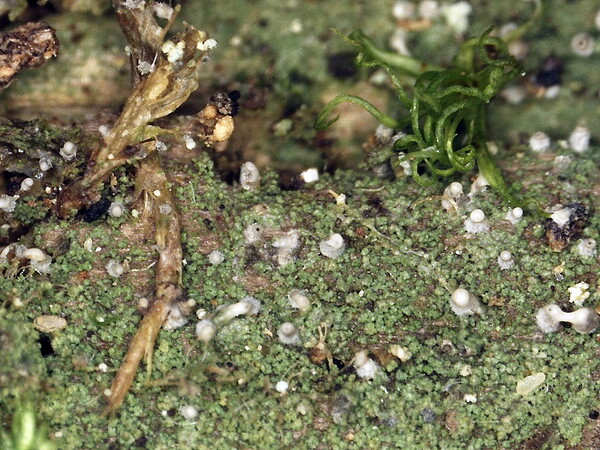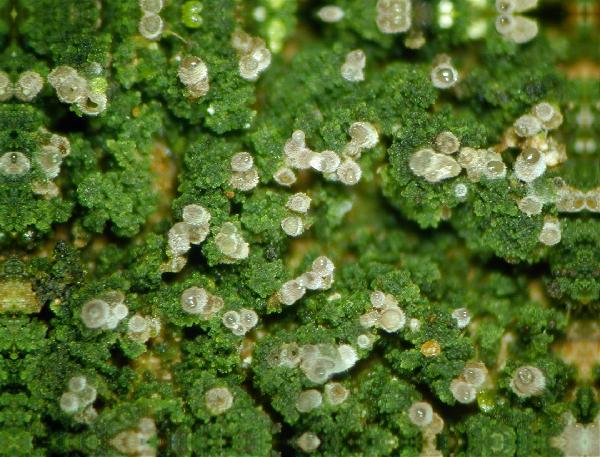Micarea hedlundii Coppins
Bull. Brit. Mus. Nat. Hist., Bot. ser., 11: 135, 1983.
Synonyms:
Distribution: N - Ven (Nascimbene & al. 2013b), TAA (Thor & Nascimbene 2007, Nascimbene & al. 2022).
Description: Thallus crustose, episubstratic, effuse, olive-green, minutely granular, composed of 20-40 µm wide goniocysts containing orange granules reacting K+ and C+ violet. Apothecia very rare, micareoid, 0.2-0.5 mm across, often aggregated in tuberculate, up to 1 mm wide clusters, pale brown to grey-brown, with a strongly convex disc, without a proper margin. Proper exciple indistinct; epithecium yellowish brown, K+ violet; hymenium colourless, often with irregular, brownish vertical streaks reacting K+ violet; paraphyses rather scanty, hyaline, branched and anastomosing, 0.8-1.5 μm thick, the apical cells only slightly wider; hypothecium colourless to yellowish, 80-130 μm high. Asci 8-spored, clavate to cylindrical-clavate, in K/I with a blue outer layer and apical dome and unstained wall, the dome with an apical cushion. Ascospores 0(-1)-septate, hyaline, ellipsoid, ovoid or oblong, 6.5-12 x 2.5-4.5 μm. Pycnidia stalked, cylindrical, usually unbranched, often extruding a whitish mass of conidia, 0.2-0.5(-1) mm tall, the stalk pink-brown or grey-brown, but covered in a whitish tomentum, the wall K+ and C+ violet. Mesoconidia narrowly ellipsoid, 4-6 x 1.2-1.7 μm. Photobiont micareoid, thin-walled, the cells 4-7 μm wide. Spot tests: thallus K- or K-+ faintly violet, C- or C+ faintly violet, P- (reactions best visible under the microscope). Chemistry: thallus with unknown orange droplets reacting K+ and C+ violet.Note: a rather rare species growing on wood (mostly on the vertical surfaces of stumps) and rotting roots of conifers in montane to subalpine forests, ranging from the Alps to Northern Europe. It is included in the Italian red list of epiphytic lichens as “Critically Endangered” (Nascimbene & al. 2013c).
Growth form: Crustose
Substrata: lignum
Photobiont: green algae other than Trentepohlia
Reproductive strategy: mainly sexual, or asexual by conidia and thalloconidia
Commonnes-rarity: (info)
Alpine belt: absent
Subalpine belt: extremely rare
Oromediterranean belt: absent
Montane belt: extremely rare
Submediterranean belt: absent
Padanian area: absent
Humid submediterranean belt: absent
Humid mediterranean belt: absent
Dry mediterranean belt: absent

Predictive model
Herbarium samples
Growth form: Crustose
Substrata: lignum
Photobiont: green algae other than Trentepohlia
Reproductive strategy: mainly sexual, or asexual by conidia and thalloconidia
Commonnes-rarity: (info)
Alpine belt: absent
Subalpine belt: extremely rare
Oromediterranean belt: absent
Montane belt: extremely rare
Submediterranean belt: absent
Padanian area: absent
Humid submediterranean belt: absent
Humid mediterranean belt: absent
Dry mediterranean belt: absent

Predictive model
| Herbarium samples |
 INDEX FUNGORUM
INDEX FUNGORUM
 GBIF
GBIF
 DOLICHENS
DOLICHENS



